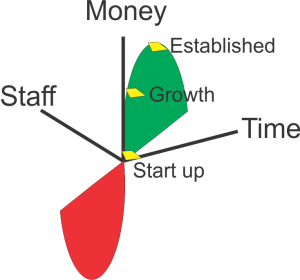Rick asked, “Have you been across the new bridge, yet?”
“No,” I said, “but I hear it is beautifully lit at night.”
“I’ve seen pictures.” said Gail, “but knowing you, I doubt you will ever cross on it as it is limited to walking, bicycles and light rail and since you don’t do any of those…”
“Pardon me for being a child of the automotive age, I sneered. What they’ve done is used modern bridge technology in support of old time transportation. That’s just what is going on with sales and marketing. Suddenly sales and marketing are being forced to cross the divide that has separated them since forever.”
“Step back from the technology Mr. Marketing,” said Kate. What do you mean ‘cross the divide?’ There is a difference between sales and marketing. Like you say, marketing is one to many but sales is one to one. That is a chasm. How is technology changing that?”
“You’ve heard about big data, right?”
“Slow down theah, Fletch,” said Rob our Georgia-born brand guru. Y’all are fixin’ to pounce like duck on a june bug. I know that tone in your voice.”
“Okay, Bubba, I replied. “The thing that is so nifty about this is that the enterprise level folks are just starting to figure out what consultants and professionals, at least the smart ones, have known for years. There’s a Forrester Report that just came out on the CMOs new role in sales enablement. What it boils down to is that:
- Marketing automation forces more communication between marketing and sales
- Better understanding of the customer life cycle creates better customer engagement.
- Marketing’s ability to probe customer concerns and interests via projections of big data analysis on individual accounts give sales deeper insights into how to more quickly build targeted trust-based relationships.
Kate jumped in, “so you’re saying that the age-old problem of Marketing not being able to figure out what a good lead is has been resolved. Is that right?”
“Only for a few companies at the enterprise level,” I said. “But as you well know from your own consulting business the divide between marketing and sales is, most of the time, not a big one. It is kind of hard for it to be when it is the same person. The only time it comes up is when a consultancy starts to grow and they add a sales person to the staff.
A consultant connects with a prospect, builds trust, reaches agreement, provides the service and maintains the relationship. There is no disconnect. Engagement flows freely from marketing activity into sales, delivery and, in the best operations, into a long term relationship.
Engagement is the key word. I believe mid-level companies can profit by building a closer relationship between marketing and sales particularly in the development of sales support materials that build trust and demonstrate real understanding of customer problems.
The Takeaway
Technology is paving the way for big companies to gather and analyze data to bridge the divide between marketing and sales. Consultants already routinely do this. Mid-level companies can move toward this new level of integration by giving sales people a starring role in helping develop communications that nurture the sale.
Jerry Fletcher’s blog recaps conversations with clients, prospects and the unruly mob of business development professionals he consorts with. They discuss marketing that works from solopreneur to enterprise level. Jerry Fletcher is the ringleader and “Watson” of the dialogue. Get all his publications at: www.JerryFletcher.com/Profit.html
Jerry has been researching and implementing small business marketing that builds businesses, careers and lives of joy for 25 years as President of Z-axis Marketing, Inc. Learn more at www.JerryFletcher.com
Schedule a personal appearance. Jerry speaks internationally on Networking, Marketing and Contact Relationship Magic. www.NetworkingNinja.com










